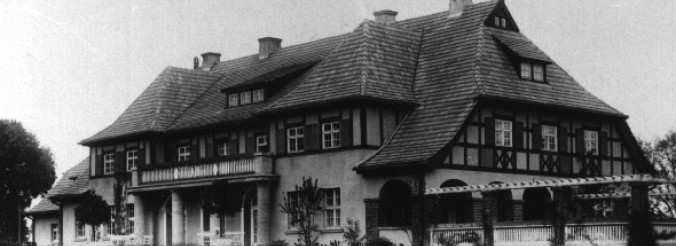The Osieki Manor House was built in 1924 by Carl Hildebrand. His grandfather, Johann Friedrich Hildebrandt bought these lands (Osieki, Rzepkowo, Kleszcze) in 1838, giving rise to a family, which managed the estates in Osieki with prudence, talent and industry until 1945. Two manor houses were built in the times of Johann Friedrich; the first one in Kleszcze, in 1848, and then in Rzepkowo at the end of 1857 and at the beginning of 1858. After the counsellor’s death, by virtue of the will, the estates were taken over by his son Robert, and then his grandson Carl Robert Hildebrand, who survived the events from March 1945 at the estates in Osieki together with his wife Katharina and their five children. Carl bequeathed the respective properties in the owned estates to his children, whereas, he decided to build a new abode for himself – the present Manor House in Osieki.
The new palace was designed by a Szczecin-based architect, Schucht. The building was situated in the middle of a beautiful English park. Its architecture, half-timbered construction, decoration of timber elements, and solid shape refers to large Pomeranian village houses. On the other hand, the clearly representative function reaches back to the tradition of palace architecture, which is emphasised by its location in a spacious park, away from the countryside. However, the scale of the building and its architecture (ground-floor modest architectural program, lack of monumental forms) clearly emphasise the manorial nature of the building.
The diary of one of the sons of Carl Hildebrand includes the following description: "The hall was hardly furnished. It served the purpose of communication as at any other manor house. The men’s room, to the right from the entrance was equipped with dark wainscotting in which libraries, a range of lined furniture in the “club” style, a large desk and an armchair for evening reading were placed. Time was counted out by an antique clock. On the left side of the hall, two living rooms were intended for women. They were called the red living room and the blue living room, based on the colour of the silk wallpaper on the walls. On top of this, the furniture for sitting was upholstered with appropriate colours; in the "red living room" - the Empire style, and in the "blue living room" - the Biedermeier style. (…) Pictures of German impressionists, including Hans Volcker, whose pictures were collected by the master of the house, were hanging on the walls. On the other side of the building, centrally from the hall, there was a dining room. The external front, lying at the terrace, provided a view through three French windows onto planes in the beech park. There, under the roof of leaves extended like a tent, the beautiful summer days were spent drinking an afternoon cup of coffee. The interior of the dining room was occupied by a large oval table made of cherry tree timber. Other furniture was also made of this timber, in the Biedermeier style, but not from that epoch but later. Various vessels stood on the cupboards” silver and crystal vases, cups, cans and boxes in different styles. (…) The music room, covered with green wallpaper was located south of the dining room. Here, next to other instruments, there was a grand piano and a harmonium (...). Also there was an alabaster bust of R. Wagner. On the northern side of the dining room, there was a cupboard, which was connected with the kitchen. Further, there was a row of chambers for the storage of food (...). Stairs led to the higher storeys; one flight of stairs ran from the back entrance, the other one from the hall. The latter led through a bypass over the hall. A desk with two antique “Gdansk chairs” stood there between the windows of the front peak. A large landscape in the Netherlands’ style hung on the wall over the stairs, it must have been old".
In March 1945 when the war reached the border of the German Reich and Rear Pomerania, the inhabitants of the Manor House in Osieki wanted to escape from the front. Unfortunately they were stopped by the Red Army, deprived of the horses pulling their belongings and left to their own devices. Carl and his wife died after exhaustive wandering near Tychów.
After the war, the manor house was transformed into offices and apartments for the employees of the Polish Agricultural Farms. Then, in 1959 it was passed to the „Association of Socialist Youth” for training purposes. In 1963, the building was taken over by the Provincial Office in Koszalin. During the Martial State, the manor house fell into ruin. In 1986 it became a possession of the Aluminium Steelworks in Konin. In 1993, the manor house was bought by Grażyna and Jerzy Jasiński. The Jasińskis refurbished the manor house and turned it into a hotel. The facility was put into service in 1996.





